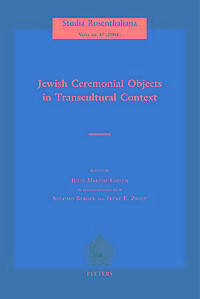
- Afhalen na 1 uur in een winkel met voorraad
- Gratis thuislevering in België vanaf € 30
- Ruim aanbod met 7 miljoen producten
- Afhalen na 1 uur in een winkel met voorraad
- Gratis thuislevering in België vanaf € 30
- Ruim aanbod met 7 miljoen producten
Zoeken
€ 48,00
+ 96 punten
Omschrijving
The opening of a new permanent exhibition on religion in the Jewish Historical Museum of Amsterdam in November 2004, which was accompanied by a catalogue entitled Gifts from the Heart: Ceremonial Objects from the Jewish Historical Museum, Amsterdam, gave rise to the idea for this volume. Both this publication and the preceding catalogue on the museum's textiles collection (1997) explore Dutch Jewish ceremonial objects, their aesthetic quality and historical background. This issue of Studia Rosenthaliana covers a wider field: the setting is Europe rather than local, and the primary focus is ceremonial objects in their transcultural context. The first cluster of contributions explore the origins of the forms and symbolism of various ceremonial objects, and interpret them as the outcome of the interplay between Jewish (religious) tradition and the surrounding culture. The articles in the second group deal with the impact of specific historical circumstances on objects, their conception and production. In the third section, two inventories of ceremonial objects belonging to Amsterdam's Sephardi and Ashkenazi communities of the seventeenth and eighteenth centuries are presented. Following our tradition, the volume concludes with an appropriate item from the Bibliotheca Rosenthaliana.
Specificaties
Betrokkenen
- Auteur(s):
- Uitgeverij:
Inhoud
- Aantal bladzijden:
- 436
- Taal:
- Nederlands
- Reeks:
- Reeksnummer:
- nr. 37
Eigenschappen
- Productcode (EAN):
- 9789042916319
- Verschijningsdatum:
- 27/05/2005
- Uitvoering:
- Hardcover
- Formaat:
- Trade paperback (VS)
- Afmetingen:
- 162 mm x 242 mm
- Gewicht:
- 784 g

Alleen bij Standaard Boekhandel
+ 96 punten op je klantenkaart van Standaard Boekhandel
Beoordelingen
We publiceren alleen reviews die voldoen aan de voorwaarden voor reviews. Bekijk onze voorwaarden voor reviews.








